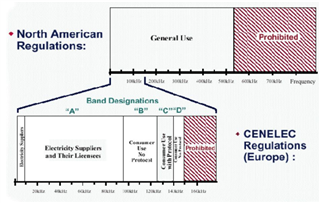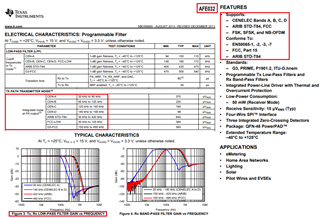Other Parts Discussed in Thread: AFE030, AFE032
Dear forum: I have a related question here in the specific case of an AFE031 based system. I am sorry if it seems like I am repeating this from a previous thread, but some stuff is still not clear to me. I understand the AFE031 can't support the full BW of the FCC band (i.e., limited to 300khz), and that is why FCC is not listed in the datasheet, but from what I can find, FCC PLC band extends from 9khz to 490khz (see below), and in many places they list FCC at 150khz to 490khz, so my questions:

1. Why is the 9khz to 150khz range not listed for FCC in many publications (including FCC)? Is it because it is allocated to other use (e.g., utility vendors)? This range of frequencies is also allocated for CENELEC (band A/B/C/D) compliant devices, but isn't CENELEC only applicable to Europe? Or can I have a device for sale in the US where it will operate in any of the CENELEC bands (9khz to 150khz range) and have it be FCC compliant/certified?
2. What is meant by "consumer use, no protocol"? does that mean I am free to come up with my own communication protocol and still be able to get it certified under FCC in those frequencies, or does it need to be a standardized protocol such as Prime/G3, etc. (assuming OFDM)?
3. Assuming I really need to be >150khz for FCC, then can't my device operate in the 150khz to 200khz range for example and still be certified under FCC?
4. Would the AFE031 + F28002x have the capability and/or processing power to handle an OFDM based protocol in this range (150khz to 200khz)? I see that for the B-FSK application example, it was estimated at ~11% utilization using 28379 running at 200Mhz. Since the F28002x runs at 100Mhz, can it still handle the task?
As to my specific PCL application, it will essentially be a PLC modem that would need to send/receive message/packets (about 50 bytes in length). The medium will be the AC lines 115/240Vac) where several of these modems (256 nodes) will be connected to and will be required to receive/decipher messages from the master node to then control lighting.
thanks for any help you can lend in clarifying any of this.
Alex



